Table of Contents
Are you looking to add a vibrant hue to your garden? Don’t go beyond Borage! These flowers are easily cultivable and offer a striking visual spectacle to your landscape and a plethora of practical applications, both culinary and medicinal. The question then arises: what are the procedures for the successful growth of Borage? Apart from its dazzling flowers, Borage is an exceptional plant companion, draws in pollinators, and repels harmful insects.
Moreover, these flowers are edible and have a cooling cucumber-like taste that compliments salads and cocktails. Before we get started in this ‘How to Grow Borage” tutorial, let’s appreciate these flowers for their utility. One may seamlessly undertake the process of growing these flowers with proper guidance and knowledge.
So, with no time to waste, let’s jump into the realm of Borage and learn how to grow these wonderful herbs!
How to Grow Borage ‘Starflower’
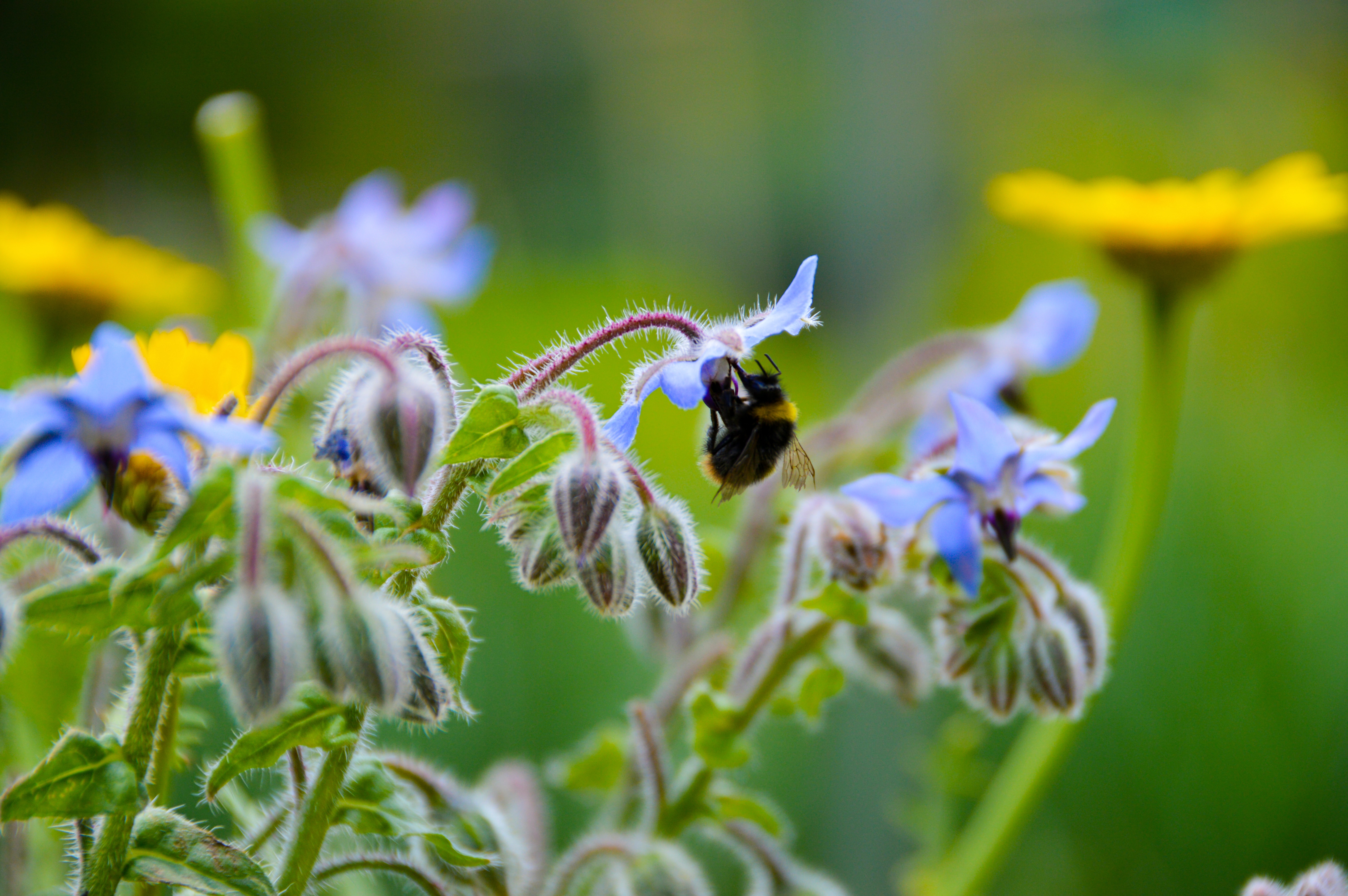
Step 1: Preparing Soil
- Find a location: The best location to plant these plants to thrive can be where they receive full sun in a partially shaded region. Also, they can reach a height of up to 3 feet, so keep the area prepared for it.
- Clearing the area: To prevent any kind of competition and have good drainage, remove weeds, all rocks and other debris from that area.
- Loosening the soil: Since these flowers need well-draining soil, with a garden fork or tiller, loosen the soil for at least 1 foot in depth.
- Soil Testing: These plants have a required soil pH of 6-7. But before testing the pH of the soil, make sure you have added organic matter and a substantial amount of nitrogen, phosphorus and potassium for their optimal growth.
Step 2: Planting Borage Seed
- Correct time: Borage can be sowed either during spring after the last week of winter or during the autumn period, approximately 6-8 weeks before the last week of winter.
- Watering the soil: One must notice that it is important to water the soil even before sowing Borage. This helps the soil to settle and gives hydration to the seed.
Step 3: Sowing the Seed
- Decide planting method: Borage seeds may be directly sown into the soil or started indoors and transplanted later. While direct sowing is an easier method, starting the germination process indoors could potentially prolong the period of growth.
- Sowing: If you are sowing directly in the ground, it is advisable to the borage seeds over the soil and then cautiously rake them in. Alternatively, you may opt to plant them in rows. If you choose to initiate the growth process indoors, ensure to fill the seed trays with potting soil and then cautiously place one or two seeds in each cell or container. Finally, cover the seeds gently with soil.
- Adding mulch: Add a moderate quantity of mulch over the area where the seed is sown. For your reference, take the area with 2 feet diameter from the seed area. Mulch helps to maintain the soil moisture and control the growing weed.
Caring Tips for Borage Plant
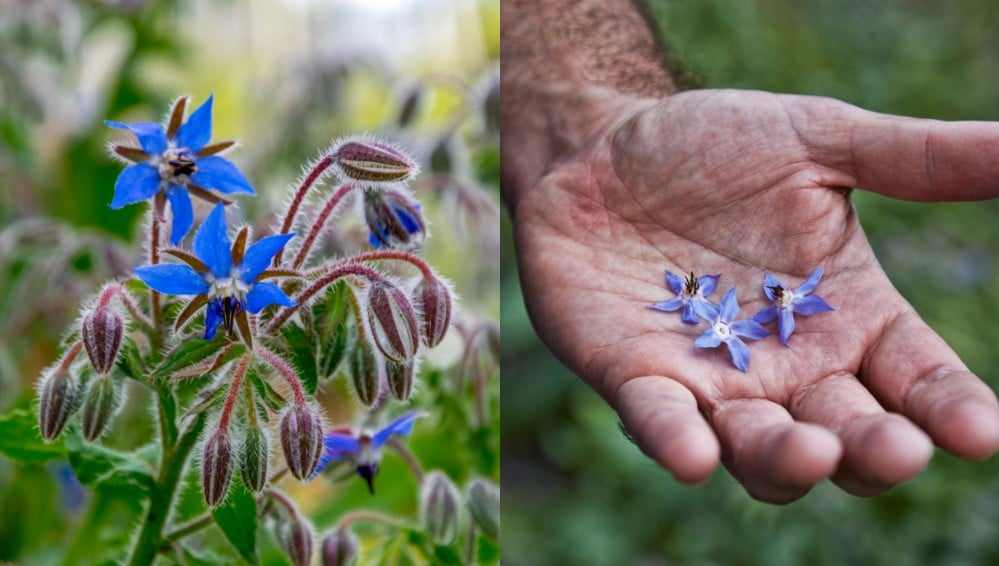
Watering: Borage plants have a consistent requirement of hydration to germinate and grow. It becomes more important to water them during the hot and dry season. However, one must not overwater them and stop the soil from becoming waterlogged.
Fertilisation: This is where the easy maintenance process starts. These flowers do not need much fertilisation. But if the soil is poor, adding compost or fertiliser a few times during the growing season will suit the best.
Pruning: Regular pruning help the flower to continue blooming. Cutting back the stem if the plant gets too tall will help it for denser growth.
Pest and disease: Make sure your plants are not eaten by some insects or have any allergies or diseases. If you notice any of these issues, don’t forget to put some insecticides or pesticides.
Harvesting: Borage leaves and flowers have a similar taste to resembling that of cucumber. Their harvest is feasible in an as-needed manner during the growth period. Furthermore, these flowers are also attractive to bees and other pollinators, thereby leaving a portion for these pollinators for them to work.
Different Types of Borage
There are majorly 5 types of Borage; they are as follows:
1. Common Borage (Borago officinalis)
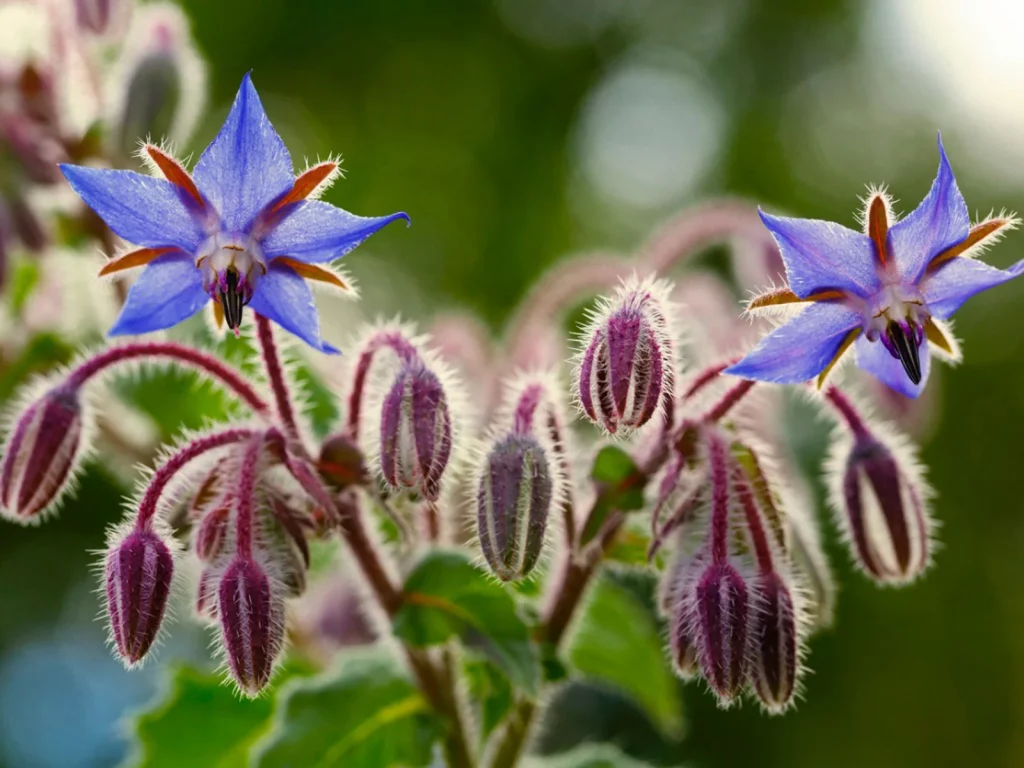
- Appearance: The Common Borage flower has a star-like appearance and five petals, generally in either pink or white colours.
- Culinary use: The Borage plant’s flower components are consumable and frequently included in culinary preparations such as salads, sweets, and potables. They offer a rejuvenating flavour matching with cucumber.
- Medicinal Properties: This plant is renowned for its medicinal properties and has historically been used to address problems such as respiratory afflictions, inflammation, and skin ailments.
2. White Borage (Borago Officinalis’ Alba’)
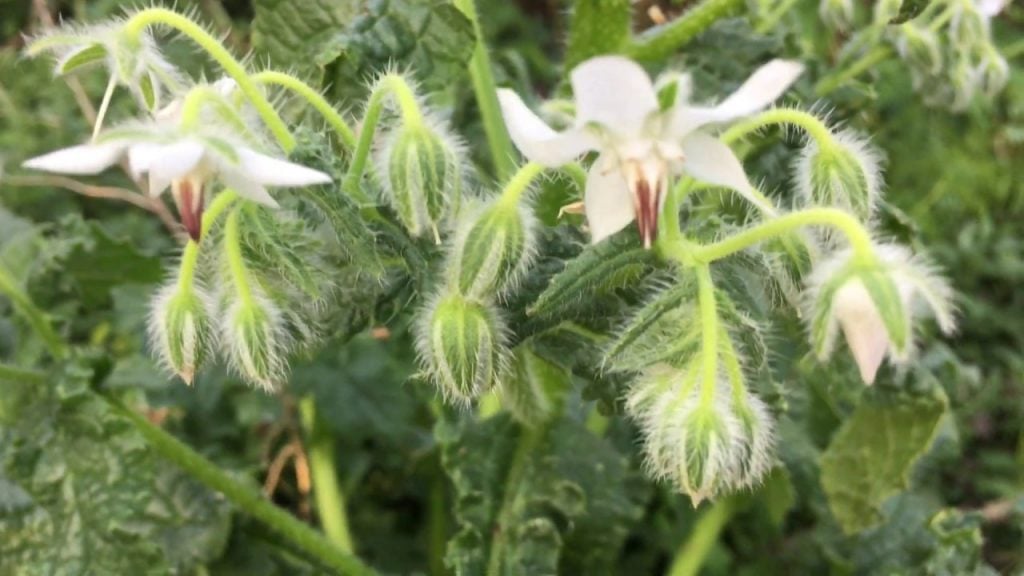
- Appearance: Like the Common Borage, the White Borage flower is star-shaped. However, their petals are white.
- Culinaryuse: These flowers are also fit for consumption and used similarly to common Borage. Notably, these flowers impart a unique visual accent to dishes by adding a white hue.
- Medicinal Properties: White Borage is revered for its medicinal properties, which are popular in treating respiratory complications, inflammation, and other health concerns.
3. Spanish Borage (Borago Hispanica)
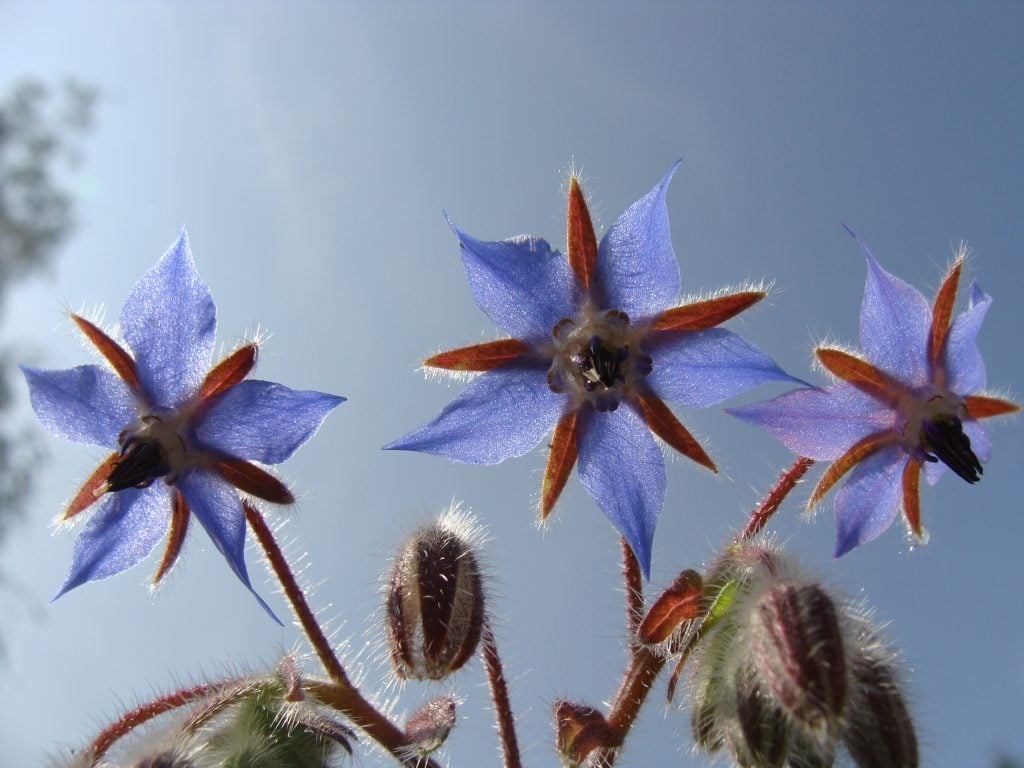
- Appearance: The Spanish Borage is a herbaceous plant that may attain a height of 1 meter, possessing resplendent blue flowers that take the shape of a star and unfurl during the summer season.
- Culinary use: The Spanish Borage frequently have used as a flavouring herb in Spanish cuisines, such as stew and soup. The plant’s leaves and flowers have a cucumber-like flavour that is refreshing and mild.
- Medicinal Properties: Furthermore, the Spanish Borage is esteemed for its medicinal properties, owing to the fact that its leaves and flowers are filled with essential fatty acids, which are believed to have anti-inflammatory and antioxidant properties.
4. Bellflower Borage (Borago Bellidifolia)
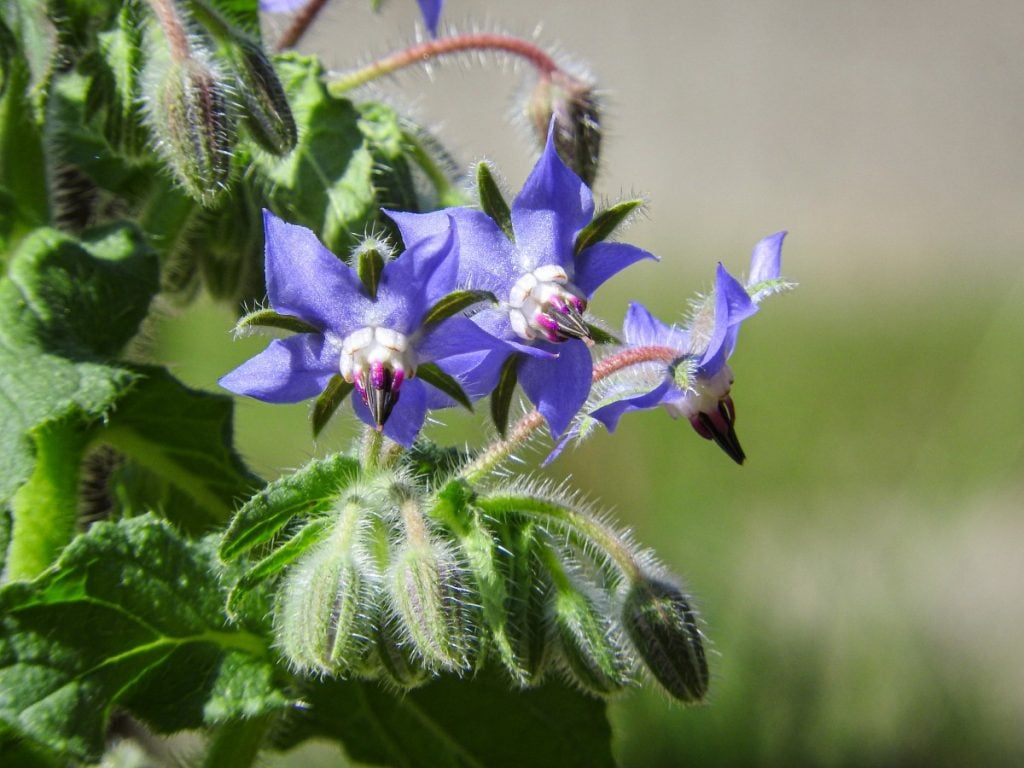
- Appearance: The bellflower Borage tends to reach a modest height of about 40 cm. It bears blue-coloured, bell-shaped flowers that come into full bloom during the summer season.
- Culinaryuse: As with the other variants of Borage, the Bellflowered Borage is also utilised as a flavouring herb in the traditional Mediterranean culinary culture. Furthermore, the plant has been used in herbal tea blends.
- Habitat: Indigenous to the Mediterranean region, this particular borage species is frequently sighted in arid and rocky habitats, such as hillsides and cliffs.
5. Variegated Borage (Borago Officinalis Variegata’)
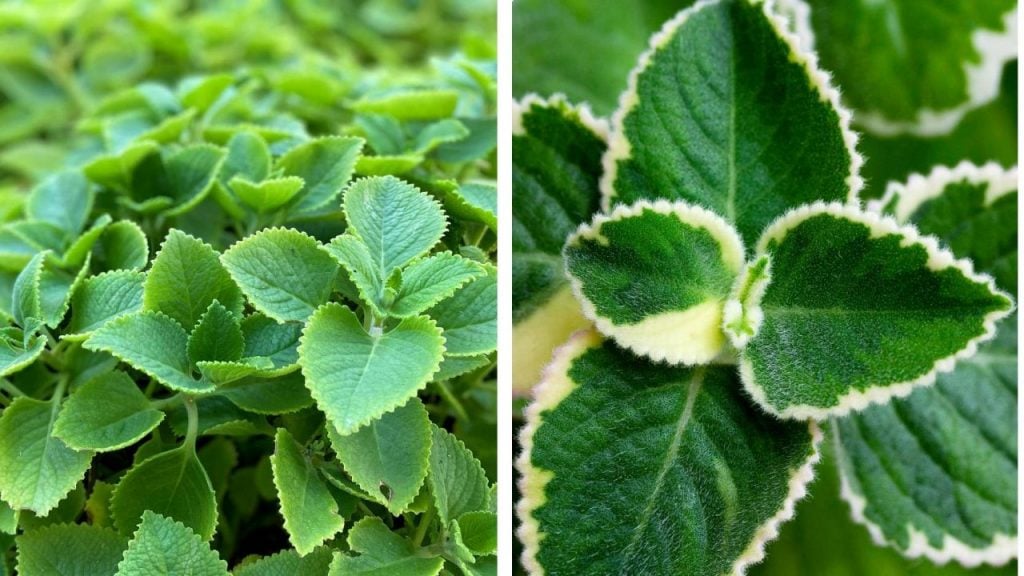
- Appearance: This particular type has green leaves with a creamy-white edge, therefore giving it a variegated appearance. As for its flowers, they are akin to those of the common Borage, distinguished by their star-shaped form and vibrant blue hue.
- Culinary use: Much like the common Borage, Variegated Borage is also highly regarded as a flavouring herb in culinary applications.
- Ornamental use: Aside from its noteworthy culinary applications, the Variegated Borage is also highly valued for its ornamental appeal. Its attractive leaves are a preferred selection for herb gardens, mixed borders, and even as a container plant.
Benefits of Growing Borage
1. Attract Pollinators
Borage flowers are known for their ability to bring pollinators like butterflies and bees to the garden. They, thereby, are a great deal of value to any garden or farm. This is mainly because these pollinators play a crucial role in increasing the yield of plants.
2. Edible and Medicinal
Borage leaves and flowers are known for their mild cucumber-like taste. They are a popular culinary ingredient used in salads, soups, and stews. These flowers are utilised in garnishing food items as well. Over all these things, Borage has been part of traditional medicines for its anti-inflammatory and diuretic properties.
3. Companion Planting
Borage, a companion plant of considerable benefit to multiple vegetable species, such as tomatoes, squash, and strawberries, has garnered significant attention from garden enthusiasts. Its ability to draw pollinators and repel pests renders it a highly desirable addition to any horticultural space.
4. Easy to Grow
Borage, a self-sufficient and undemanding annual plant, necessitates minimal effort for cultivation. The plant can be conveniently grown from seed and flourishes in areas with either complete exposure to the sun or partial shadow. Furthermore, it boasts an extended flowering season, which adds vibrancy and fascination to the garden throughout the entire summer.
5. Soil Improvement
Borage has a taproot that can go down up to 24 to 36 inches beneath the soil, serving as a tool to loosen compacted soil and thereby improve drainage. Its extensive roots enable it to accumulate nutrients from lower soil layers and supply them to other plant species when its leaves decompose. Borage is known as a good soil builder and is frequently utilised as a ground cover or a green manure crop.
Common Problems with Borage
Borage is a common plant; however, people can face small changing which are important to sustain those plants-
Bad Germination: Borage seeds present a challenging task for germination due to their rigid exterior surface. Consequently, the seeds’ sprouting may take an extended duration, or some seeds may fail to germinate altogether. To optimise the probability of successful germination, it is advisable to soak the seeds in water for an entire night before sowing them or to remove the seed coat to stimulate seed sprouting.
Overwatering: Borage thrives in well-draining soil, as opposed to waterlogged. Excess watering tends to induce root rot formation, which can be fatal to the plant’s vitality. It is of utmost importance to ensure the proper moisture of the soil, preventing it from becoming dead and allowing any extra water to drain away from the roots.
Pest: Borage is weak to the depredations of pests, especially aphids and caterpillars. These creatures significantly damage the plant’s flowers and leaves. While aphids eat the plant’s sap, causing deformities in the leaves, caterpillars consume the leaves, leaving the plant in a weakened state. To stop pests, natural pest-controlling methods are recommended. These methods include introducing beneficial insects or applying a soap and water solution to the plant to remove the pests.
Summing It Up
All in all, borage is an extraordinary plant flower that possesses the potential to improve the aesthetic of any garden. It has aesthetically pleasing blue star-shaped petals, which have numerous culinary uses and medical applications.
If you want to cultivate and care for Borage, this article will surely assist you in setting you on the appropriate path. Firstly, Borage plants need full sunlight and well-drained soil. However, they can endure in less favourable conditions, such as partial shade and impoverished soil. As a result, it is a superb alternative for those beginners in the horticulture industry. Secondly, consistent watering is essential to ensure the soil remains damp, but care must be taken to avoid excessive watering, which can trigger root decay. Furthermore, they need monthly fertilisation throughout the growing season, which will promote their proper development. Lastly, it is an annual plant self-seeding in nature, allowing it to reproduce by itself if given a chance to produce seeds.
If you desire to maintain a consistent stock of Borage in your garden year after year, this characteristic can be very beneficial. To promote this natural process of reproduction, one simply needs to allow some of the plant’s flowers to dry up and transform into seeds.
Frequently Asked Questions
How to Sow The Borage Seeds?
Borage plants need effortless propagation and prosper easily from the seeds they bear. It is highly suggested to plant these seeds directly into the soil where they will be allowed to mature as it doesn’t tolerate transplantation effectively. Sowing these seeds into well-draining soil during the spring, after the last week of winter, or in the autumn is best.
These seeds should be planted 1/4 inch beneath the soil and kept apart by 6-12 inches. Although Borage thrives under full exposure to sunlight, it can endure some shade. The plant is also highly durable and capable of surviving in meagre soil conditions; however, it prospers best in fertile soil. After planting, gently sprinkle water over the seeds and moisten the soil until the seedlings sprout.
What is the Water Requirement in The Borage Plant?
Borage is drought-tolerant; it has a preference for damp soil. Irrigating the plant regularly is important, particularly during arid and sweltering weather conditions. Instead of lightly watering the plant daily, watering it deeply once a week is recommended. One should exercise caution not to water it excessively as it could result in root decay. In addition, a layer of mulch surrounding the plant’s base can aid in maintaining moisture levels in the soil, thereby assisting the plant.
What Is the Height of Borage?
Borage possesses the potential to ascend to the impressive height of 2-3 feet while spanning a width of 1-2 feet. Due to its impressive growth rate, the plant bears beautiful, blue-hued flowers that flourish throughout the summer season. To facilitate optimal development, it is vital to give ample space for this flower, as it has the ability to attain a big size.
Additionally, Borage may benefit from providing support structures, especially when cultivated in areas prone to strong gusts of wind. Regular pruning and deadheading are also crucial in new growth.





